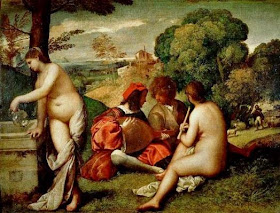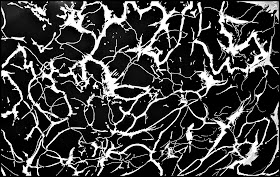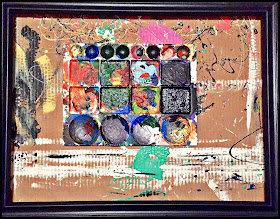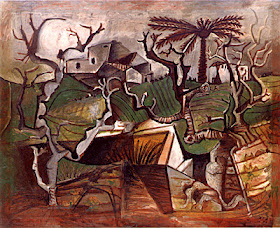 |
| Remake of Rouault's: Flowers in a Yellow Vase 1939 C.T. Rasmuss, acrylic (2014). |
 |
| Flowers in a Yellow Vase 1939 Georges Rouault, oil. |
For the last few years I've been focusing a lot of my effort on studying the masters, comprising mostly of the Impressionists like Cezanne and Manet; Post Impressionists: Gauguin and Van Gogh; Modernists: Matisse, Derain, Braque, Mondrian, and as you see above, Georges Rouault; Surrealists: Miro, Chagall and Dali; Abstract Expressionists: Pollock, Rothko and Mark Toby; as well as countless other artists and their respective movements, too many to mention.
As a result of studying these artists, I've been inspired 10 fold; as to opposed to if I had never picked up a book based on them, their work or, especially seeing it in person. Every time I paint, I understand that: no artist especially, can claim to be 100% autonomous in their efforts, no matter how hard they try, so I say why not just embrace it and use it to our advantage, the way I believe it was intended; just like the masters before us payed homage to those before them: how these greats admit truth and thereby profit from those compounded truths.
 |
| Remake: Alexej Von Jawlensky's Portrait of Alexander Sakharoff 1909 Paulo Guimaraes (2014). |
 |
| Alexej Von Jawlensky's Portrait of Alexander Sakharoff 1909, oil. |
Below is a statement by friend and artist Paulo Guimaraes, who inspired this post and the need for such a post. He's the creator of the Jawlensky Remake above, which I personally prefer to the original; this makes total sense if you think about it, given that Paulo is a more than capable artist who claims to be still learning, but this is how all the masters felt if you asked them especially even in their later years, also his painting is more up to date, as I will give you an example of what I mean, after Paulo's statement on this pressing issue in today's art-world:
Paulo
Guimaraes:
The 21st century has been a time of technological advances in
medicine, computers, cellphones, and even in the Art world. Much of
the art I see through online gallery websites, have been created by
digital means or are paintings “perfect” in execution, they
follow the style of old masters such as Da
Vinci, Michelangelo, or
Rodin.
This perfection is as pretty as a photograph. However, it was not
long ago that photographs replaced these same realistic works of art;
inviting a new bread of artist to take over, radical in thought,
action, and execution.
These
such artists were Picasso,
Matisse, Duchamp, Pollock, Dali, Miro,
and so on; these artists changed the face of art in the way, that
anything could be considered art. And I am one who agrees with this
with all my heart, I feel the art world of today needs to re-focus on
the Masters of Abstract
expressionism, Surrealism, Dadaism, Automatism,
etc. the movements their artwork and accompanying doctrines helped
establish - The rebel 'isms' of the art world.
Lately
I've been on a mission to remake some artworks by these rebellious
artists, as an homage to their greatness and will to step outside the
box, for the sake of all of us. It seems to me that today's art
loving public want something exactly like the original as
reproductions/prints. But to me, this is a disservice to the Masters
of the strange exciting and originality! To pay true homage to the
arts, we must embrace their work and then make it our own, add our
own flavor to the mix and bring new life into the old!! Join me and
artists like C.T. Rasmuss, as we witness the Phoenix
come alive once again!!
 |
| Self Portrait & Vesuvius Man Leonardo Da Vinci, drawings (1490). |
 |
| Ceiling of Sistine Chapel Michelangelo, fresco (1508-12). |
The two photos above, are perfect examples of realism and the exactness(what Paulo was referring to) in standards of painting set by Leonardo Davinci's iconic,
Vetruvian Man, such exactness acclaimed in the Michelangelo's painting of
The Sistine Chapel. Then in the mid-19th century a shift started to happen, a split actually, right around the time of the invention of the photograph, eventually(as Paulo pointed out) for many artists there was no longer the need for accuracy, because the photograph could do it better(exactness of Vetruvian Man) and thanks to photographers like Alfred Stieglitz and and Ansel Adams at the turn of the century, they started to infiltrate the art world and give the camera legitimacy.
Georgia Okeefe Hands 1919, Alfred Stieglitz.
Church & Abandoned Automobile Ansel Adams 1957.
So today, you can do a
remake or reproduction of the above two photos or any painting you like really, but the difference is, a
remake is to: make(something) again or differently and
reproduction is the: action or process of making a
copy of something.
So there you have it, so when an artist sets out to paint a "remake", with an intent to learn through another artist, such as one of the Masters of the past he is not copying something, but indeed doing a remake with an intent to create something anew! To bring it into the future perhaps, I think it's very important for artists today to make this distinction, because Isle 7 of your nearest Walmart is full of reproductions, and as artists is up to you and I to do what we can to help tear down isle 7 with all our will, and thereby creating and obsolescence for such TRASH(reproductions)..
And when I mean Trash I'm talking about poster reproductions of:
Starry Night, Escher's
Night and Day,
The Mona Lisa, etc. even those more expensive canvas prints, and especially cheap reproductions of mediocre contemporary art; all for the sole purpose of "makin a quick buck"! Original art is vital to the art movement and a strong culture, and remakes are an integral part of it, as opposed to the damage caused by a multitude of mere reproductions.
Here's one of my favorite examples of an (extreme) remake; which there are many throughout art history, you just need to find them, and I truly hope you to introduce even more great art:
 |
| The Luncheon on The Grass Edouard Manet, oil (1862-63). |
 |
| The Pastoral Concert Giorgione or Titian, oil (ca. 1510). |
Manet's inspiration for his:
The Luncheon on the Grass was
The Pastoral Concert, painted back in the time of the Renaissance and something even more interesting has just come to my attention; thanks to this inquiry I was able to discover the following information on Picasso's homage to Manet's single masterpiece(a great artwork I've been intrigued with ever since art school) I found it on the MoMA's website:
"The painting Luncheon on the Grass by Édouard Manet was the starting point for an extensive series by Picasso, including twenty–seven paintings, one hundred and fifty drawings, eighteen maquettes, and five prints."
link to: MoMA article.
 |
| Picasso remake: Edouard Manet's The Luncheon on the Grass. |
Picasso remake: Edouard Manet's
The Luncheon on the Grass.
So I leave you with this in mind, even the greatest of artists such as Picasso, really all of them, "pay homage" to the greats before them, so why not us, I feel the art-world has tried to turn its back on its past for too long, which has created a weakness in this once grandiose field, much like music has turned to POP rubbish, we believe it's time for a Neo-Renaissance, and this is a good example of how to start defining that movement.
 |
| Remake of Modigliani's: Madame Survage by Paulo Guimaraes. |
 |
| Madame Survage Modigliani, oil. |
We can only get better as a whole, and that takes guts!!!





























































